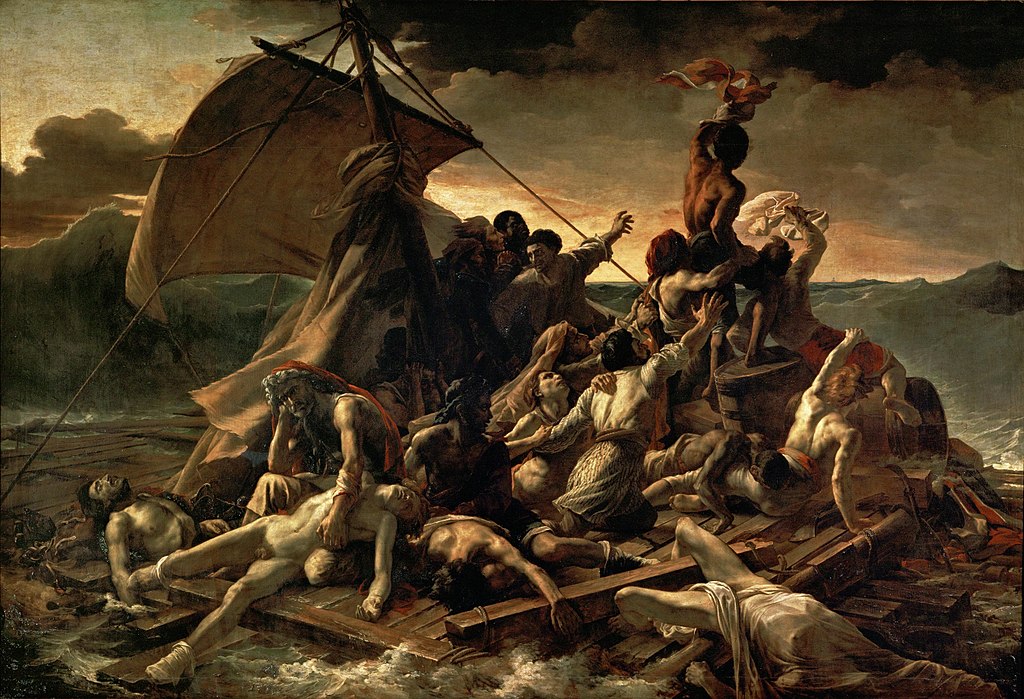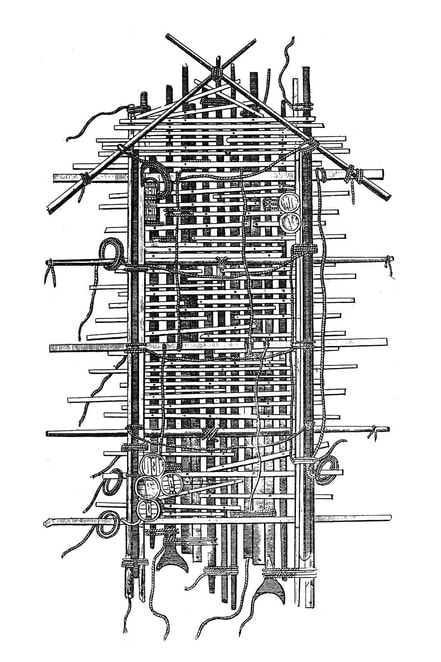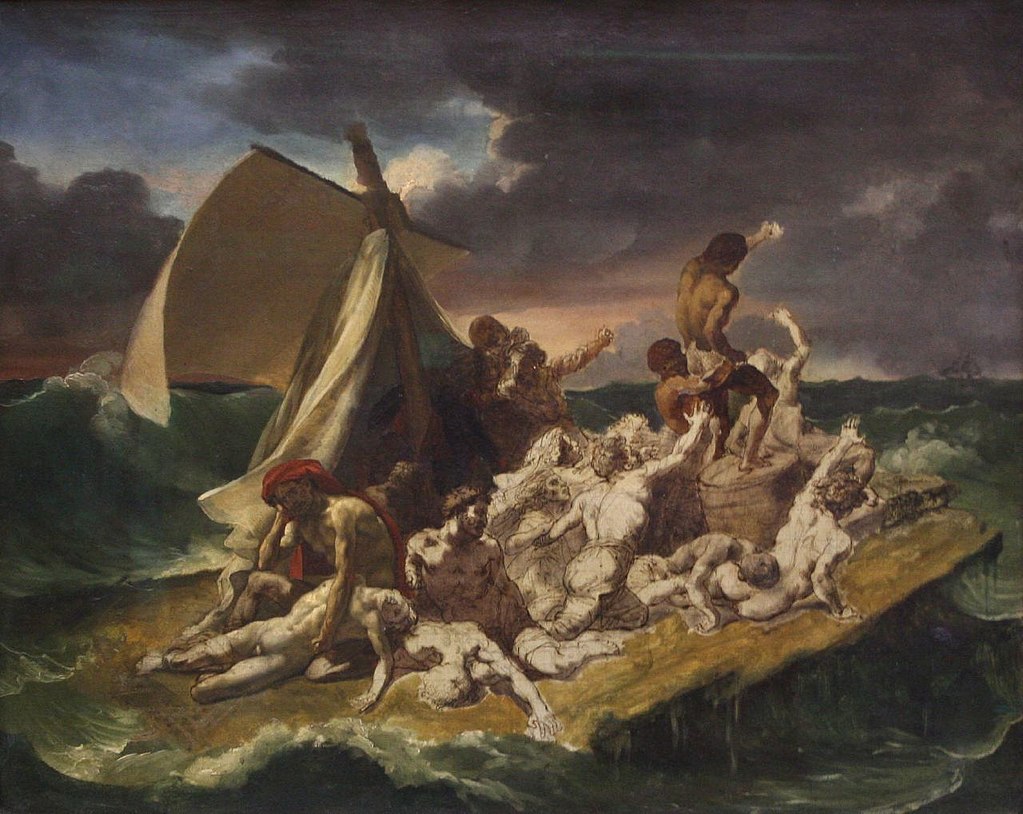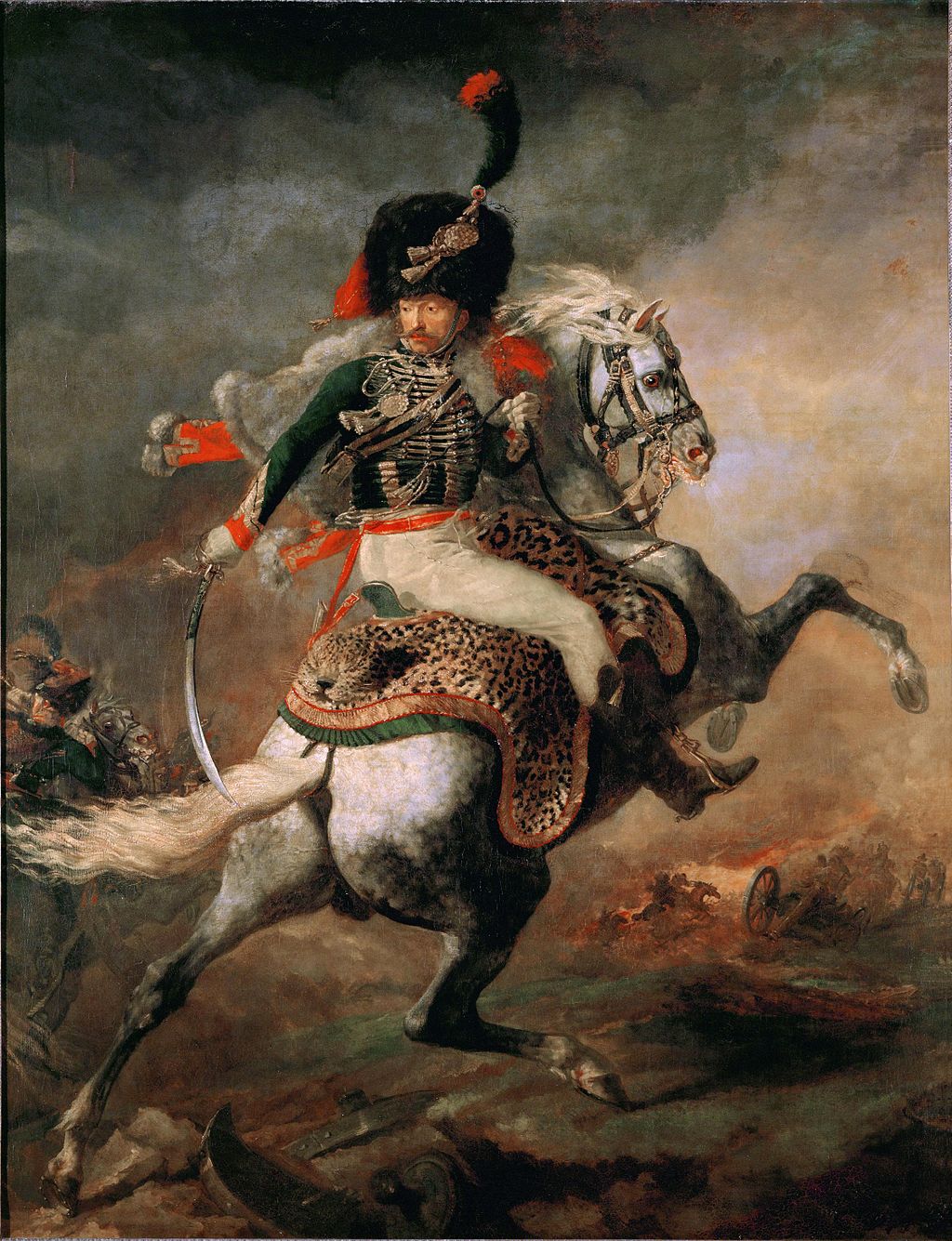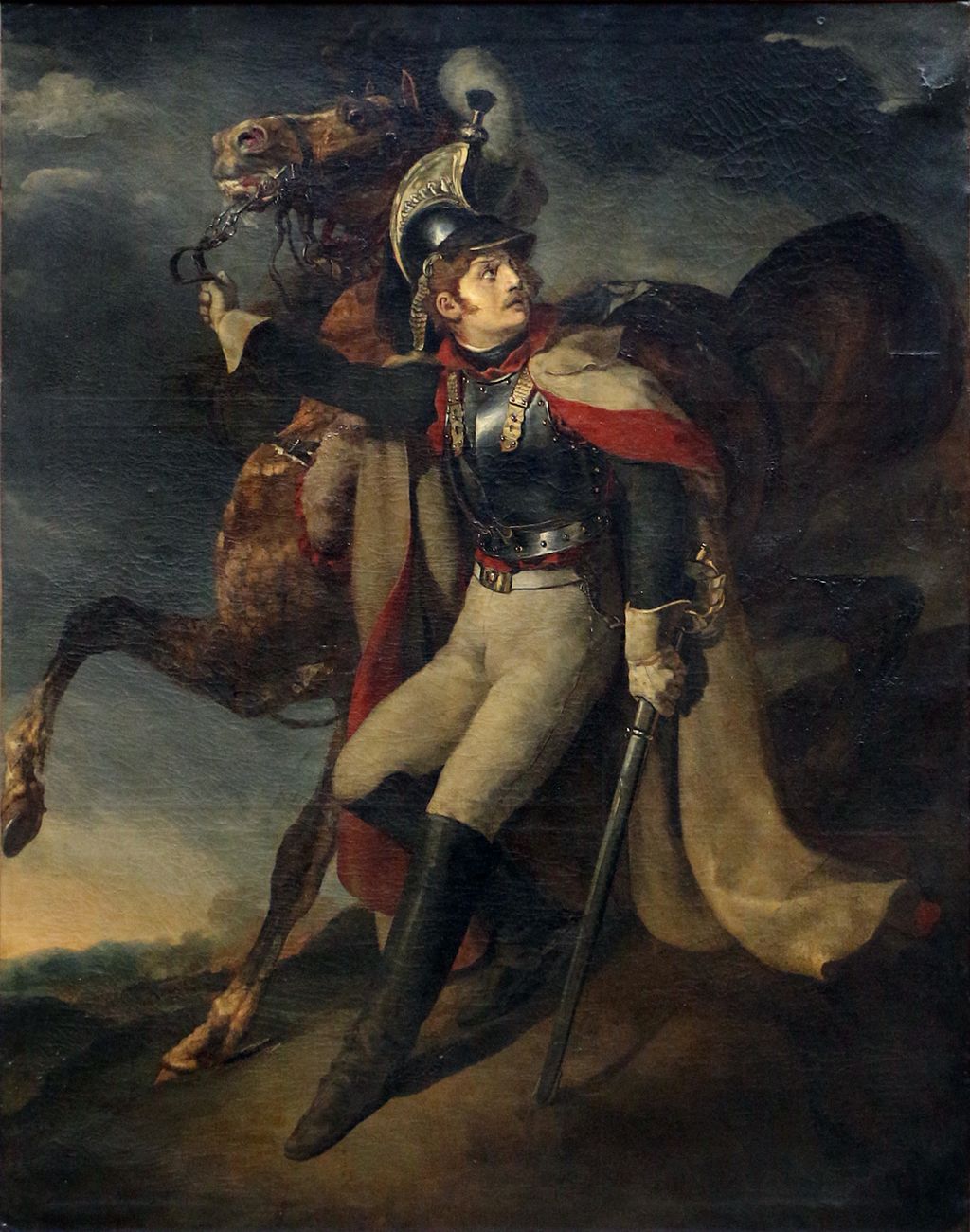|
Where? First floor, room 700 of the Denon wing in the Louvre
When? 1818-1819 What do you see? A moment about two hours before the survivors of a shipwreck are rescued. After spending 13 days on a raft on the open sea – surrounded by big waves – the surviving members of The Medusa notice a ship on the horizon (see the tiny ship on the horizon above the man on the right with a red garment around his upper legs). Some of the survivors frantically try to get the attention of the ship. However, they are unsuccessful at first and only two hours later the ship locates the raft and the survivors are rescued. The improvised raft carries 20 people. It seems that there are four or five dead bodies, mostly in the foreground. The survivor that reaches highest is an African man. Géricault gave this man a very prominent place as a political statement against slavery. The man stands with his right leg on a barrel of wine, which is the only liquid they had to drink on the raft. In the left foreground, a father with a red cloth holds the dead body of his son in front of him. What it the Raft of the Medusa? The Medusa was a French warship. In 1816, it left from Rochefort, France, in the direction of Senegal, where the British would hand over the port of Saint-Louis to the French. The ship carried 400 passengers. Navigational mistakes caused the ship to run aground in shallow water about 30 miles (50 km) from the coast of Mauritania. The ship was damaged, and the passengers needed to be evacuated. However, there were not enough lifeboats to carry everybody. The majority of passengers used the lifeboats to get to the African coast. About 150 people got on an improvised raft of 66 ft (20m) long and 23 ft (7m) wide (see the picture below based on a drawing of one of the survivors). There was very little food on the raft, it was half underwater, and could not be steered. So, these people were lost at sea. Many of them died because of a lack of food, fights, suicide, or cannibalism. When the raft was discovered by a rescue ship 13 days later, only 15 people were alive (of which five died within days after their rescue). Two survivors wrote a book about their experiences and the full text of that book is available for free.
Backstory: Within two months of the rescue, the first accounts of the brutal journey of the raft of the Medusa appeared in French newspapers. These stories caused a big scandal in France and the government tried to cover it up unsuccessfully. Géricault got inspired by these stories and wanted to start a painting about it.
Géricault spoke to two survivors to get an even better idea of what they experienced. He picked a specific moment from their survival story as the subject for this large painting. He also tracked down the carpenter that helped to build the raft from the wooden deck of the Medusa and asked him to create a smaller-scale replica in his studio. Many of the preparatory sketches by Géricault for this painting are still available. A more elaborate sketch that is also owned in the Louvre is shown below. All this preparation resulted in a brilliantly-executed painting. According to many, this is the most famous painting from the Romantic art period.
Moral: The moral is one of despair, hope, and persistence. After 13 days, the people on the raft finally see a ship that could rescue them. However, the ship does not seem to see them. Some people in this painting are still trying to get the attention of the ship, while others have already given up, turned around, and sit down in disappointment.
Who is Géricault? Jean-Louis André Théodore Géricault (1791-1824) was a painter and lithographer from France. He is one of the founders of Romanticism, an art movement that was further developed by Eugene Delacroix. While Géricault received some formal training, he was largely self-educated. He got his inspiration from Michelangelo, Gros, and especially Rubens. Géricault was a specialist in painting horses. His first masterpiece, The Charging Chasseur, which is also in the Louvre, was accepted for the Paris Salon of 1812. Two years later another painting of him got accepted by the Salon, entitled The Wounded Cuirassier, which is on display both in the Louvre and in the Brooklyn Museum of Art in New York.
Fun fact: The Raft of the Medusa painting was a controversial one and Géricault was aware of that. The painting was a political statement against the government who had failed in appointing a proper captain to the Medusa and, subsequently, tried to cover up their mistakes in handling the aftermath.
Géricault used a canvas of 23.6 ft (716 cm) wide and 16.1 ft (491) cm high, making the figures in this painting larger than life-size. He knew that he would not sell this painting as it was too big for a private home and the government would not buy it. The painting got accepted for the 1819 Paris Salon and immediately went viral, becoming the talk of the town. As expected he did not sell it, but he earned some money when the painting toured various exhibitions in Europe, where the painting was received positively. Interested in a copy for yourself? Poster.
Written by Eelco Kappe
References:
0 Comments
Leave a Reply. |
Categories
All
|
- Home
- Blog
-
Museums
- Alte Pinakothek
- Art Institute of Chicago
- Baltimore Museum of Art
- Barber Institute of Fine Arts
- Bargello
- Barnes Foundation
- British Museum
- Church of Sant’Anastasia
- Cleveland Museum of Art
- Courtauld Institute of Art
- Detroit Institute of Arts
- Frans Hals Museum
- Galleria Borghese
- Gallerie dell'Accademia
- Getty Museum
- Guggenheim
- Hermitage Museum
- Kunsthistorisches Museum
- Kunstmuseum Basel
- Legion of Honor Museum
- Louvre
- Mauritshuis
- Metropolitan Museum of Art
- Musee d’Orsay
- Museum of Fine Arts in Boston
- Museum of Modern Art
- National Gallery in London
- National Gallery of Art
- National Museum in Poznań
- Norton Simon Museum
- Ny Carlsberg Glyptotek
- Palace of Versailles
- Palazzo Pitti
- Palazzo Vecchio
- Petit Palais
- Philadelphia Museum of Art
- Prado
- Pushkin Museum
- Ravenna Art Museum
- Rijksmuseum
- San Diego Museum of Art
- Santa Maria delle Grazie
- St. Peter's Basilica
- Städel Museum
- Statens Museum for Kunst
- Tate Britain
- Tate Modern
- Timken Museum of Art
- Uffizi
- Vatican Museums
- Wallace Collection
-
Artists
- Altdorfer
- Anguissola
- Berlin Painter
- Bosch
- Botticelli
- Boucher
- Bronzino
- Bruegel the Elder
- Brunelleschi
- Cabanel
- Caillebotte
- Canova
- Caravaggio
- Carpeaux
- Cezanne
- Cimabue
- David
- Degas
- Delacroix
- De Maria
- Donatello
- El Greco
- Fontana
- Fra Angelico
- Fragonard
- Gauguin
- Gentileschi
- Gericault
- Gonzalez-Torres
- Goya
- Hals
- Hogarth
- Hokusai
- Ingres
- Leonardo da Vinci
- Lippi, Filippo
- Longhi, Barbara
- Lorrain
- Makovsky
- Manet
- Massys
- Matisse
- Merian
- Michelangelo
- Mochi
- Modigliani
- Monet
- Panini
- Parmigianino
- Perugino
- Picasso
- Pisanello
- Raphael
- Rembrandt
- Renoir
- Reynolds
- Rivera
- Rodin
- Rubens
- Scultori
- Seurat
- Steen
- Tintoretto
- Titian
- Toulouse-Lautrec
- Turner
- Uccello
- Van der Weyden
- Van Dyck
- Van Eyck
- Van Gogh
- Van Hemessen
- Vasari
- Velazquez
- Vermeer
- Veronese
- Vigée Le Brun
-
Locations
- Books
- About Us

